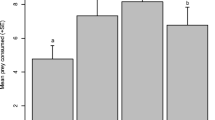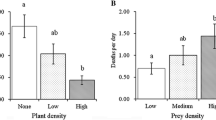Abstract
Structurally complex habitats provide cover and may hinder the movement of animals. In predator–prey relationships, habitat structure can decrease predation risk when it provides refuges for prey or hinders foraging activity of predators. However, it may also provide shelter, supporting structures and perches for sit-and-wait predators and hence increase their predation rates. We tested the effect of habitat structure on prey mortality in aquatic invertebrates in short-term laboratory predation trials that differed in the presence or absence of artificial vegetation. The effect of habitat structure on prey mortality was context dependent as it changed with predator and prey microhabitat use. Specifically, we observed an ‘anti-refuge’ effect of added vegetation: phytophilous predators that perched on the plants imposed higher predation pressure on planktonic prey, while mortality of benthic prey decreased. Predation by benthic and planktonic predators on either type of prey remained unaffected by the presence of vegetation. Our results show that the effects of habitat structure on predator–prey interactions are more complex than simply providing prey refuges or cover for predators. Such context-specific effects of habitat complexity may alter the coupling of different parts of the ecosystem, such as pelagic and benthic habitats, and ultimately affect food web stability through cascading effects on individual life histories and trophic link strengths.


Similar content being viewed by others
References
Alexander ME, Dick JTA, O’Connor NE, Haddaway NR, Farnsworth KD (2012) Functional responses of the intertidal amphipod Echinogammarus marinus: effects of prey supply, model selection and habitat complexity. Mar Ecol Progr Ser 468:191–202. doi:10.3354/meps09978
Almany GR (2004) Differential effects of habitat complexity, predators and competitors on abundance of juvenile and adult coral reef fishes. Oecologia 141:105–113. doi:10.1007/s00442-004-1617-0
Bartholomew A (2002) Total cover and cover quality: predicted and actual effects on a predator’s foraging success. Mar Ecol Prog Ser 227:1–9. doi:10.3354/meps227001
Bartholomew A, Diaz RJ, Cicchetti G (2000) New dimensionless indices of structural habitat complexity: predicted and actual effects on a predator’s foraging success. Mar Ecol Prog Ser 206:45–58. doi:10.3354/meps206045
Boukal DS (2014) Trait- and size-based descriptions of trophic links in freshwater food webs: current status and perspectives. J Limnol 73:171–185. doi:10.4081/jlimnol.2014.826
Burks RL, Jeppesen E, Lodge DM (2001) Littoral zone structures as Daphnia refugia against fish predators. Limnol Oceanogr 46:230–237. doi:10.4319/lo.2001.46.2.0230
Canion CR, Heck KL Jr (2009) Effect of habitat complexity on predation success: re-evaluating the current paradigm in seagrass beds. Mar Ecol Prog Ser 393:37–46. doi:10.3354/meps08272
Carter MW, Shoup DE, Dettmers JM, Wahl DH (2010) Effects of turbidity and cover on prey selectivity of adult smallmouth bass. Trans Am Fish Soc 139:353–361. doi:10.1577/T08-159.1
Convey P (1988) Competition for perches between larval damselflies: the influence of perch use on feeding efficiency, growth rate and predator avoidance. Freshwater Biol 19:15–28. doi:10.1111/j.1365-2427.1988.tb00323.x
Cresswell W, Lind J, Quinn JL (2010) Predator-hunting success and prey vulnerability: quantifying the spatial scale over which lethal and non-lethal effects of predation occur. J Anim Ecol 79:556–562. doi:10.1111/j.1365-2656.2010.01671.x
Crowder LB, Cooper WE (1982) Habitat structural complexity and the interaction between bluegills and their prey. Ecology 63:1802–1813. doi:10.2307/1940122
de Roos AM, McCauley E, Wilson WG (1991) Mobility versus density-limited predator–prey dynamics on different spatial scales. Proc R Soc B 246:117–122. doi:10.1098/rspb.1991.0132
de Szalay F, Resh VH (2000) Factors influencing macroinvertebrate colonization of seasonal wetlands: responses to emergent plant cover. Freshwater Biol 45:295–308. doi:10.1111/j.1365-2427.2000.00623.x
Delclos P, Rudolf VHW (2011) Effects of size structure and habitat complexity on predator–prey interactions. Ecol Entomol 36:744–750. doi:10.1111/j.1365-2311.2011.01324.x
Denno RF, Gratton C, Peterson MA, Langellotto GA, Finke DL, Huberty AF (2002) Bottom-up forces mediate natural-enemy impact in a phytophagous insect community. Ecology 83:1443–1458. doi:10.2307/3071956
Denno RF, Finke DL, Langellotto GA (2005) Direct and indirect effects of vegetation structure and habitat complexity on predator–prey and predator–predator interactions. In: Barbosa P, Castellanos I (eds) Ecology of predator–prey interactions. Oxford University Press, Oxford, UK, pp 211–239
Diehl S (1992) Fish predation and benthic community structure: the role of omnivory and habitat complexity. Ecology 73:1646–1661. doi:10.2307/1940017
Dionne M, Butler M, Folt C (1990) Plant-specific expression of antipredator behaviour by larval damselflies. Oecologia 83:371–377. doi:10.1007/BF00317562
Dolson R, McCann K, Rooney N, Ridgway M (2009) Lake morphometry predicts the degree of habitat coupling by a mobile predator. Oikos 118:1230–1238. doi:10.1111/j.1600-0706.2009.17351.x
Eklöv P, Diehl S (1994) Piscivore efficiency and refuging prey: the importance of predator search mode. Oecologia 98:344–353. doi:10.1007/BF00324223
Eklöv P, VanKooten T (2001) Facilitation among piscivorous predators: effects of prey habitat use. Ecology 82:2486–2494. doi:10.1890/0012-9658(2001)082[2486:FAPPEO]2.0.CO;2
Flynn AJ, Ritz (1999) Effect of habitat complexity and predatory style on the capture success of fish feeding on aggregated prey. J Mar Biol Assoc UK 79:487–494
Giacomini HC, De Marco P (2008) Larval ecomorphology of 13 Libellulidae (Anisoptera, Odonata) of the Middle Rio Doce Valley, Minas Gerais, Brazil. Braz J Biol 68:211–219. doi:10.1590/S1519-69842008000100031
Gotceitas V, Colgan P (1989) Predator foraging success and habitat complexity: quantitative test of the threshold hypothesis. Oecologia 80:158–166
Grabowski JH, Hughes AR, Kimbro DL (2008) Habitat complexity influences cascading effects of multiple predators. Ecology 89:3413–3422. doi:10.1890/07-1057.1
Hauzy C, Tully T, Spataro T, Paul G, Arditi R (2010) Spatial heterogeneity and functional response: an experiment in microcosms with varying obstacle densities. Oecologia 163:625–636. doi:10.1007/s00442-010-1585-5
Hedges LV, Gurevitch J, Curtis PS (1999) The meta-analysis of response ratios in experimental ecology. Ecology 80:1150–1156. doi:10.1890/0012-9658(1999)080[1150:TMAORR]2.0.CO;2
Horinouchi M, Mizuno N, Jo Y, Fujita M, Sano M, Suzuki Y (2009) Seagrass habitat complexity does not always decrease foraging efficiencies of piscivorous fishes. Mar Ecol Prog Ser 377:43–49. doi:10.3354/meps07869
Howard RK, Koehn JD (1985) Population dynamics and feeding ecology of pipefish (Syngnathidae) associated with Eelgrass beds of Western Port, Victoria. Aust J Mar Freshwater Res 36:361–370
Huffaker CB (1958) Experimental studies on predation: dispersion factors and predator–prey oscillations. Hilgardia 27:795–835
Iwata T (2007) Linking stream habitats and spider distribution: spatial variations in trophic transfer across a forest-stream boundary. Ecol Res 22:619–628. doi:10.1007/s11284-006-0060-6
James PL, Heck KJ (1994) The effects of habitat complexity and light intensity on ambush predation within a simulated seagrass habitat. J Exp Mar Biol Ecol 176:187–200. doi:10.1016/0022-0981(94)90184-8
Johnson DM (1991) Behavioral ecology of larval dragonflies and damselflies. Trends Ecol Evol 6:8–13. doi:10.1016/0169-5347(91)90140-S
Klecka J (2014) The role of a water bug, Sigara striata, in freshwater food webs. PeerJ 2:e389. doi:10.7717/peerj.389
Klecka J, Boukal DS (2012) Who eats whom in a pool? A comparative study of prey selectivity by predatory aquatic insects. PLoS ONE 7:e37741. doi:10.1371/journal.pone.0037741
Klecka J, Boukal DS (2013) Foraging and vulnerability traits modify predator–prey body mass allometry: freshwater macroinvertebrates as a case study. J Anim Ecol 82:1031–1041. doi:10.1111/1365-2656.12078
Kovalenko KE, Thomaz SM, Warfe DM (2012) Habitat complexity: approaches and future directions. Hydrobiologia 685:1–17. doi:10.1007/s10750-011-0974-z
Langellotto GA, Denno RF (2004) Responses of invertebrate natural enemies to complex-structured habitats: a meta-analytical synthesis. Oecologia 139:1–10. doi:10.1007/s00442-004-1497-3
Lombardo P (1997) Predation by Enallagma nymphs (Odonata, Zygoptera) under different conditions of spatial heterogeneity. Hydrobiologia 356:1–9. doi:10.1023/A:1003038717605
Manatunge J, Asaeda T, Priyadarshana T (2000) The influence of structural complexity on fish–zooplankton interactions: a study using artificial submerged macrophytes. Environ Biol Fishes 58:425–438. doi:10.1023/A:1007691425268
Mattila J, Heck KL Jr, Millstein E, Miller E, Gustafsson C, Williams S, Byron D (2008) Increased habitat structure does not always provide increased refuge from predation. Mar Ecol Prog Ser 361:15–20. doi:10.3354/meps07392
McCann KS, Rasmussen JB, Umbanhowar J (2005) The dynamics of spatially coupled food webs. Ecol Lett 8:513–523. doi:10.1111/j.1461-0248.2005.00742.x
Meerhoff M, Iglesias C, De Mello FT, Clemente JM, Jensen E, Lauridsen TL, Jeppesen E (2007) Effects of habitat complexity on community structure and predator avoidance behaviour of littoral zooplankton in temperate versus subtropical shallow lakes. Freshwater Biol 52:1009–1021. doi:10.1111/j.1365-2427.2007.01748.x
Michel MJ, Adams MM (2009) Differential effects of structural complexity on predator foraging behaviour. Behav Ecol 20:313–317. doi:10.1093/beheco/arp005
Nelson WG, Bonsdorff E (1990) Fish predation and habitat complexity: are complexity thresholds real? J Exp Mar Biol Ecol 141:183–194. doi:10.1016/0022-0981(90)90223-Y
Osenberg CW, Sarnelle O, Cooper SD (1997) Effect size in ecological experiments: the application of biological models in meta-analysis. Am Nat 150:798–812. doi:10.1086/286095
Osenberg CW, Sarnelle O, Cooper SD, Holt RD (1999) Resolving ecological questions through meta-analysis: goals, metrics, and models. Ecology 80:1105–1117. doi:10.2307/177058
Peckarsky BL (1984) Predator–prey interactions among aquatic insects. In: Resh VH, Rosenberg DM (eds) Ecology of aquatic insects. Praeger, New York, pp 196–254
R Core Team (2012) R: A language and environment for statistical computing. R Foundation for Statistical Computing, Vienna. http://www.R-project.org
Sanders D, Nickel H, Grützner T, Platner C (2008) Habitat structure mediates top–down effects of spiders and ants on herbivores. Basic Appl Ecol 9:152–160. doi:10.1016/j.baae.2007.01.003
Savino JF, Stein RA (1982) Predator–prey interactions between largemouth bass and bluegills as influenced by simulated vegetation. Trans Am Fish Soc 111:255–266. doi:10.1577/1548-8659(1982)111<255:PIBLBA>2.0.CO;2
Scheinin M, Scyphers SB, Kauppi L, Heck KL Jr, Mattila J (2012) The relationship between vegetation density and its protective value depends on the densities and traits of prey and predators. Oikos 121:1093–1102. doi:10.1111/j.1600-0706.2011.19941.x
Schmitz OJ, Křivan V, Ovadia O (2004) Trophic cascades: the primacy of trait-mediated indirect interactions. Ecol Lett 7:153–163. doi:10.1111/j.1461-0248.2003.00560.x
Swisher BJ, Soluk DA, Wahl DH (1998) Non-additive predation in littoral habitats: influences of habitat complexity. Oikos 81:30–37. doi:10.2307/3546464
Tolonen KT, Hämäläinen H, Holopainen IJ, Mikkonen K, Karjalainen J (2003) Body size and substrate association of littoral insects in relation to vegetation structure. Hydrobiologia 499:179–190. doi:10.1023/A:1026325432000
Toscano BJ, Griffen BD (2013) Predator size interacts with habitat structure to determine the allometric scaling of the functional response. Oikos 122:454–462. doi:10.1111/j.1600-0706.2012.20690.x
Warfe DM, Barmuta LA (2004) Habitat structural complexity mediates the foraging success of multiple predator species. Oecologia 141:171–178. doi:10.1007/s00442-004-1644-x
Warfe DM, Barmuta LA (2006) Habitat structural complexity mediates food web dynamics in a freshwater macrophyte community. Oecologia 150:141–154. doi:10.1007/s00442-006-0505-1
Wirtz K (2012) Who is eating whom? Morphology and feeding type determine the size relation between planktonic predators and their ideal prey. Mar Ecol Prog Ser 445:1–12. doi:10.3354/meps09502
Acknowledgments
We thank A. P. Beckerman, L. Berec, D. J. Mikolajewski and anonymous reviewers for comments that helped us improve the manuscript at various stages of preparation. The study was supported by the Grant Agency of the University of South Bohemia (GAJU 145/2010/P), the EU Marie Curie European Reintegration Grant AquaMod to D. S. B. (PERG04-GA-2008-239543) and the Grant Agency of the Czech Republic (grant no. P505/10/0096). The use of tadpoles in the experiment was permitted by the regional authority (permit no. KUJCK 12524/2010 OZZL/2/Do) and the Ministry of Education of the Czech Republic (permit no. 7947/2010 30).
Author information
Authors and Affiliations
Corresponding author
Additional information
Communicated by Joel Trexler.
Electronic supplementary material
Below is the link to the electronic supplementary material.
Rights and permissions
About this article
Cite this article
Klecka, J., Boukal, D.S. The effect of habitat structure on prey mortality depends on predator and prey microhabitat use. Oecologia 176, 183–191 (2014). https://doi.org/10.1007/s00442-014-3007-6
Received:
Accepted:
Published:
Issue Date:
DOI: https://doi.org/10.1007/s00442-014-3007-6




